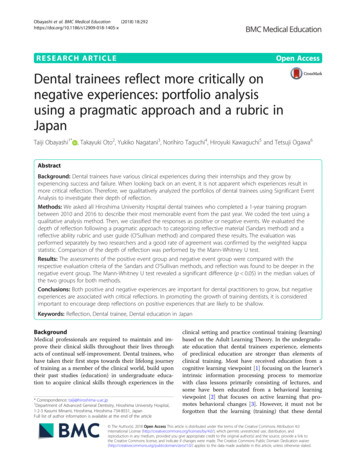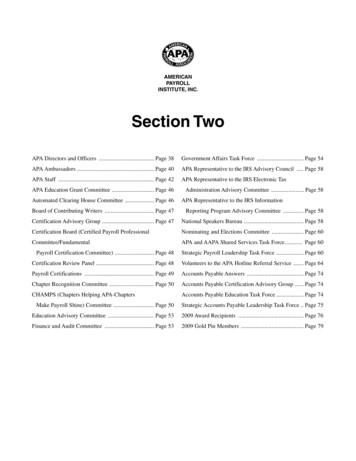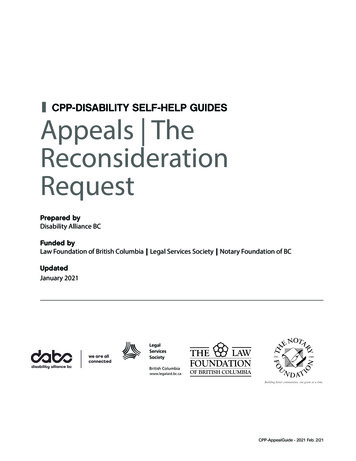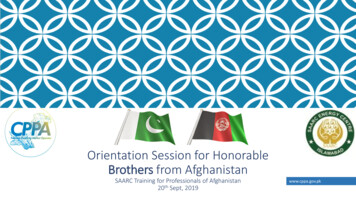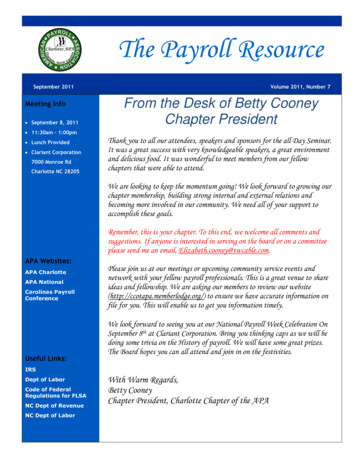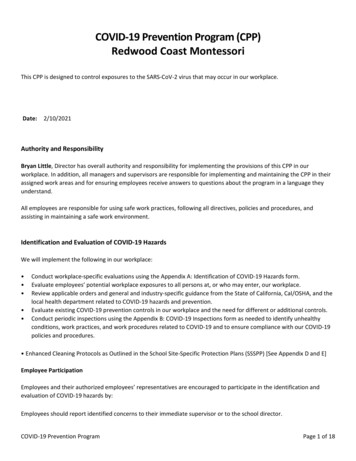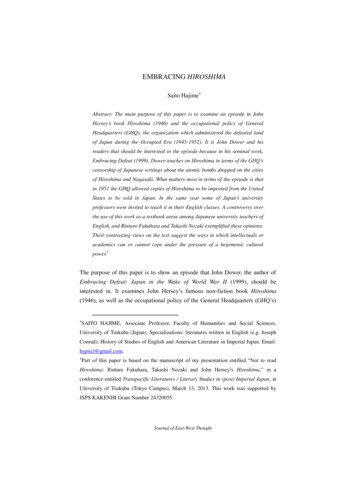
Transcription
EMBRACING HIROSHIMASaito Hajime Abstract: The main purpose of this paper is to examine an episode in JohnHersey’s book Hiroshima (1946) and the occupational policy of GeneralHeadquarters (GHQ), the organization which administered the defeated landof Japan during the Occupied Era (1945-1952). It is John Dower and hisreaders that should be interested in the episode because in his seminal work,Embracing Defeat (1999), Dower touches on Hiroshima in terms of the GHQ’scensorship of Japanese writings about the atomic bombs dropped on the citiesof Hiroshima and Nagasaki. What matters most in terms of the episode is thatin 1951 the GHQ allowed copies of Hiroshima to be imported from the UnitedStates to be sold in Japan. In the same year some of Japan’s universityprofessors were invited to teach it in their English classes. A controversy overthe use of this work as a textbook arose among Japanese university teachers ofEnglish, and Rintaro Fukuhara and Takashi Nozaki exemplified these opinions.Their contrasting views on the text suggest the ways in which intellectuals oracademics can or cannot cope under the pressure of a hegemonic culturalpower.1The purpose of this paper is to show an episode that John Dower, the author ofEmbracing Defeat: Japan in the Wake of World War II (1999), should beinterested in. It examines John Hersey’s famous non-fiction book Hiroshima(1946), as well as the occupational policy of the General Headquarters (GHQ’s) SAITO HAJIME, Associate Professor, Faculty of Humanities and Social Sciences,University of Tsukuba (Japan). Specializations: literatures written in English (e.g. JosephConrad); History of Studies of English and American Literature in Imperial Japan. Email:hspstcl@gmail.com.1Part of this paper is based on the manuscript of my presentation entitled “Not to readHiroshima: Rintaro Fukuhara, Takashi Nozaki and John Hersey’s Hiroshima,” in aconference entitled Transpacific Literatures / Literary Studies in (post) Imperial Japan, atUniversity of Tsukuba (Tokyo Campus), March 13, 2013. This work was supported byJSPS KAKENHI Grant Number 24320055.Journal of East-West Thought
92SAITO HAJIMEin censoring any atomic bomb related writings published in Occupied Japan(1945-1952). Most importantly, the episode shows the ways in which Japaneseacademics negotiated with, if not directly resisted, the power of the GHQ and ofthe United States. Their reactions to the GHQ give us insights into the effects ofcensorship on intellectuals as well as academic freedom during occupation.I. Hiroshima in 1951, JapanIn Chapter 14 of Embracing Defeat, “Censored Democracy: Policing the NewTaboos,” Dower discusses “a new taboo” against the atomic bombs that the USArmy dropped on Hiroshima and Nagasaki:Writing about the atomic-bomb experience was not explicitly proscribed, andin the year or so following the surrender, especially in local publications in theHiroshima area, a number of writers were able to publish prose and poetry onthe subject. At the same time, however, survivors such as Nagai Takashi foundtheir early writings suppressed, many bomb-related writings were severely cut,and the most moving English-language publication on the subject – JohnHersey’s Hiroshima, a sparse portrait of six survivors that made a profoundimpression when published in The New Yorker in August 1946 – thoughmentioned in the media, could not be published in translation until 1949.(Dower, 1999: 414)It seems unnecessary to talk much about Hersey’s Hiroshima. This famousreportage holds a secure place in the history of the twentieth century Americanjournalism. In 1993, Bart Barnes wrote an obituary to Hersey (1917 - 1993) inThe Washington Post that “it was in Hiroshima that Mr. Hersey produced aliterary classic and made publishing history with a non-polemical description ofthe atomic blast in the Japanese city of Hiroshima on Aug. 6, 1945” (Barns 1993).The most important phrase is “a non-polemical description,” suggesting thatHersey focused not on who dropped the first atomic bomb on the city ofHiroshima but on how six people experienced the terrible explosion and survivedit. Due to this “non-polemical description,” “as a book Hiroshima sold 118,000copies in hardcover and more than 3.4 million in paperback” (ibid.), and the GHQpermitted the Japanese translation of the book to be published in 1949. NoJapanese readers of the book could find such a straightforward description that,Journal of East-West Thought
EMBRACING HIROSHIMA93for example, the US Army dropped the Fat Man on Hiroshima City and killedtens of thousands of civilians there. A simple question lingers here. In 1949, didJapanese people welcome and accept (or embrace) Hersey’s “non-polemicaldescription” of the atomic blast that destroyed Hiroshima city? The Hiroshimacontroversy that I will discuss in what follows can be a key to answering thequestion.II. To Read Hiroshima or not to Read ItIn 1951, The Rising Generation (Eigo Seinen), one of the most influentialmonthly magazine in the field of English Studies in Japan 2, ran a short articleentitled “Hiroshima is Being Sold in Japan” (“Hiroshima no kokunai hanbai").John Hersey’s Hiroshima is now being sold by Hosei University Press 3(Fujimicho, Chiyoda Ward, Tokyo), which is a special case. The originalpublisher Knopf volunteers to sell the book with no care for commercial concerns– a copy of it costs 1.75 [US dollars], but it is sold in Japan for 200 hundred yen 4– because the original publisher would like to support the ‘No more Hiroshimas’movement and to make a contribution to the peace of the world. It is said thatbulk orders of the book for textbook, for instance, will be further considered interms of price. (The Rising Generation, June 1951, 45)5It is too naïve to believe in Alfred Knopf’s spirit of volunteerism or thepublisher’s “support” for peace movements. The phrase “which is a special case”2The Rising Generation, or Eigo Seinen (most of the articles are written in Japanese), has a115 years history (from 1898 to 2009 in print; to 2013 in web), and has long been regardedas a kind of the official report of English and American literary studies, English linguisticsand English education in the twentieth century Japanese society. The Web Eigo Seinenceased to exist in March 2013.3Hosei University Press (Hosei Diagaku Shuppan Kyoku) was founded in 1948, and it isthis publisher that published the first Japanese translation of Hiroshima in 1949 that was intruth the publisher’s first publication. Since then, Hosei UP has published innumerableacademic translations of European and Anglo-American philosophies and literatures.4In 1951, one dollar was equal to 360 yen. Undoubtedly, Knopf and Hosei UP soldHiroshima at a bargain price.5Except for Hersey 1946, Barnes 1993 and Dower 1999, all the quotations in this paper aretranslated from Japanese texts into English by the author of the paper.Journal of East-West Thought
94SAITO HAJIMEstrongly suggests the presence of an organization that made the selling of copiesof Hiroshima “special.” A certain organization directly or indirectly controlled theevent, and it is safe to conclude that GHQ, the organization that had allowed aJapanese translation to be published in 1949, making copies of Hiroshima to beavailable for Japanese students in 1951 - so that they were invited to read a“non-polemical description” about Hiroshima and the atomic bomb. They couldgratify their desire to know about what happened, but they could hardly thinkabout who was responsible for the bombing. The important fact is that theproliferation of the book Hiroshima within Japanese society brought about acontroversy. Two months later, the same Eigo Seine ran another short articleentitled “Hiroshima Chosen as Textbook” (“Hiroshima kyokasho ni”).We have already reported here that John Hersey’s Hiroshima was madeavailable in Japan. The news is that the book was chosen as a textbook in eightuniversities including the University of Hiroshima. Asahi Shimbun (May 23)reported university teachers’ contrasting opinions on this issue. Professor TakashiNozaki (Chuo University6) chose Hiroshima and told the newspaper that “I wouldlike to teach living American English and with this book in hand I would also liketo ponder on peace.” Professor Rintaro Fukuhara (Tokyo University ofEducation7), who rejected it, told: “it takes almost one year to teach it in ourclasses, and many of my colleagues told me that it was terrible to teach, in eachclass hour, the fact that people were killed in air raids.” (The Rising Generation,August 1951, 45)It is here I introduce Nozaki and Fukuhara, who are less known in andoutside Japan, in order to address what matters in this quotation. Nozaki (1917 –1995) was born in Hirosaki, a city in the Aomori Prefecture, in the northern partof the mainland of Japan, Honshu. He studied English Literature at TokyoImperial University in 1941. He started his academic career in Hirosaki but soonmoved to Tokyo. He taught English literature in Chuo University (1950); Tokyo6Established in 1885, the university has been long (and still is) regarded as one of the mostpopular and famous private universities in the Tokyo area.7Tokyo Higher Normal School was founded in 1872 as a kind of the École normalesupérieure in order to train high school and university teachers. The name of the schoolhas changed three times: Tokyo University of Science and Literature (1929); TokyoUniversity of Education (1949); University of Tsukuba (1973 - present).Journal of East-West Thought
EMBRACING HIROSHIMA95Metropolitan University8 (1971-1981); Teikyo University (1981-1995)9. In hislife he has been a prolific translator of American literature: his translationsinclude Fitzgerald’s The Great Gatsby, Hemingway’s The Old Man and the Sea,Richard Right’s Black Boy, John Barth’s The Sot-Weed Factor, to name a few.10His fame as a translator still owes much to his hugely successful 1964 translationof J. D. Salinger’s The Catcher in the Rye (1951) in which Nozaki boldly used1960’s Japanese slangs: about 250 million copies had been sold until HarukiMurakami’s 2007 translation replaced Nozaki’s. 11 He has devoted his life touniversity education and translation of the famous (and less famous) twentiethcentury American literary works. Fukuhara (1895 – 1981) is no less famous thanNozaki both in and outside the field of English literary studies and education inthe twentieth century Japan. Born in the village of Kamimura, in the western partof Hiroshima Prefecture, he entered Tokyo Higher Normal School to learnEnglish in 1912. He was so excellent that he was invited by the editors of TheRising Generation (Eigo Seinen) to write essays and ultimately to be itseditor-in-chief. In 1921, he became an associate professor of his old school. In1929, the Japanese Government sent him to England, and he studied in Londonand Cambridge Universities (1929-1931). In 1939, he became a professor of thesame school. In 1946, he became the President of Japan Association of EnglishLiterature (1946–1953). In 1949, he became the head of the Department ofLiterature in Tokyo University of Science and Literature (1949-1953). In 1964, hewas named as a member of the Japan Art Academy. In 1968, he was named aPerson of Cultural Merit. His literary and occasional essays and academic studies(on Thomas Gray and Charles Lamb, for instance) are collected in CollectedWorks in 12 volumes (1969-1970) and in posthumously published CollectedEssays in 8 volumes (1983).12 The fact that many of his writings were collected8Tokyo Metropolitan University (Tokyo Toritsu Daigaku) was established in 1949 and wasclosed in 2011 by the Metropolis of Tokyo (succeeded by Shuto Daigaku Tokyo [theEnglish name is Tokyo Metropolitan University]).9Established in 1966, this private university is one of the largest universities located in theTokyo a.10In terms of Nozaki’s biography, I have referred to Koizumi (ed.) 1990, Ueda et al (eds.)2001 and an obituary in Asahi Shimbun May 17, 1995.11See Chujo 2003.12In terms of Fukuhara’s biography, I have referred to Saito (ed.) 1985.Journal of East-West Thought
96SAITO HAJIMEand published during his life and immediately after his death amply proves thatJapanese society has needed him during the Cold War era. With the knowledge ofNozaki and Fukuhara, let me touch on the implications of the fact that the formeraccepted Hiroshima and the latter did not.III. Nozaki’s Choice of HiroshimaI have no clear answer as to why he chose it, mainly because there is no study ofthe ways in which he thought on a book bearing the name of Hiroshima city thatwas given by the former enemy whom destroyed the city. 13 A clue to thisquestion can be found in Nozaki’s study on Ernest Hemingway (1960). 14 In thelast chapter entitled “Beyond Hemingway” (“Hemingway wo koete”), he showedhis social concerns about “the horrifying development of nuclear weapons, therecent appearance of an artificial satellite, the fear of ‘death ash’, the fear of theWorld War III, and our expectation of the meeting of the leaders of the Big Two”(Nozaki, 91). He continued to argue that some of contemporary American writerswho were inclined to represent the experiences of ordinary people could hardlyfind something new to express (ibid.), and he concluded that Hemingway avoided“issues concerning society and humanity in The Old Man and the Sea (1954)” sothat Nozaki hoped “a new generation of writers - Irwin Shaw, Norman Mailer,Saul Below, William Styron, Ralph Ellison, J. D. Salinger – to inherit Hemingwayand to go beyond him” (ibid, 94). Nozaki so earnestly hoped “a new generationsof writers” to be read in Japan that he translated some of them (Ellison andSalinger, for instance). He didn’t prefer literature to society.It is undeniably the fact that Nozaki chose the “non-polemical” Hiroshimathat was deemed safe by GHQ, but Nozaki’s views on literature and society in his1960 study shows that he was not a kind of scholar-translator who would easilylike to love pureness of literature and to dislike social issues in the nuclear age. Inother words, he chose Hiroshima; but it is still possible to assume that he read thetext with his students in order to “ponder on” (or examine) the nature of peace orPax Americana.13There is no detailed study of the cultural and political significance of Nozaki’stranslation (including the hugely successful 1964 translation of The Catcher in the Rye) inthe last quarter of the twentieth century, either.14To my knowledge, this is the only academic study that he has published in his life.Journal of East-West Thought
EMBRACING HIROSHIMA97IV. Fukuhara’s RejectionFukuhara’s rejection of Hiroshima can be justified in what follows. First of all, hewas right when he said to Asahi Shimbun that it took at least one year to teach thebook. Until recently, many of Japanese university teachers of English have oftentold their students to translate only one or two pages of the whole textbook intoJapanese in each class (90 minutes long) and the teachers have spent most of thetime to correct the student’s translation so as not to help students discuss it but tohelp them become a kind of translators like Nozaki. In Fukuhara’s view, a bookwith 118 pages was not a good choice for his Japanese students who could notread faster than native speakers of English. Secondly, it is important to note thatevery reader of the book has to read a series of descriptions of the victims by theatomic bomb, one of which is as follows. After “a tremendous flash of light”(Hersey 1946, 8), the Reverend Kiyoshi Tanimoto, one of the six survivors onwhom Hersey focused, saw in the street where he rumbled on,[ ] a squad of soldiers who had been burrowing into the hillside opposite,making one of the thousands of dugouts in which the Japanese apparentlyintended to resist invasion, hill by hill, life for life; the soldiers were comingout of the hole, where they have been safe, and blood was running from theirheads, chests, and backs. They were silent and dazed. (ibid: 9-10)With these words, Fukuhara and his colleagues, many of whom lived in Tokyo,might have remembered a series of air raids on the city that culminated in theGreat Tokyo Air Raid (March 10, 1945) in which lives of 100,000 people arereported to have been lost; some of the survivors of the raid saved their lives inthe “dugouts” that they had made by themselves. Although Fukuhara was notdirectly wounded by the air raids, he saw a part of his study room in hisuniversity bombed and burnt. When Fukuhara told the Asahi Shimbun that “it wasterrible to teach, in each class hour, the fact that people were killed in air raids,”he was honest enough to show his anger against those who told him to choose abook that could help the Japanese readers remember the terrible experiences thatthey actually had.I would like to add another explanation of Fukuhara’s rejection that he didn’ttell in the Asahi Shimbun interview. The third reason has much to do with hisJournal of East-West Thought
98SAITO HAJIMEindifference toward the atomic bomb and with his isolationism. As I have arguedelsewhere in detail15, he has written so little about the atomic bomb that USAdropped on Hiroshima. In fact, he has written only a few words about it in his1945 Diary (Showa 20 nen no nikki), and he has written only three short essays inThe Rising Generation (Eigo Seinen) in which he wrote briefly about the damagesthat University of Hiroshima suffered and about his hope for its swiftreconstruction. They are all of what he has written about Hiroshima and theatomic blast. Let me touch on his 1945 Diary. On 7 August, he noted that“yesterday, Hiroshima was attacked with a new-type bomb” (Fukuhara 1959, 84).On August 8th, he noted that Mr. Furusawa, a bureaucrat of Ministry of ForeignAffairs, told him “the atomic bomb dropped on Hiroshima resulted in immenseharm” (ibid. 85). On August 11th, he showed sympathy with a Hiroshima-bornlieutenant commander named Sato who lost all communication with his familiesin Hiroshima (ibid. 90). On 21 August, Fukuhara noted that Shin’ichiro Tomoaga,one of his colleagues and a Nobel Prize laureate (physics in 1965), told him thatthe bomb that “the US Army dropped on Hiroshima was undoubtedly an atomicbomb” (Fukuhara 1962, 97). This is the last reference to Hiroshima and theatomic bomb, although he continued to write his diary until October 20 in 1945.In this regard, Fukuhara’s 1955 essay entitled “A Retired Professor Has FreeTime” (“Teinen kyoju kanka ari”) deserves attention. This essay contains his 1952lecture entitled “English Literature as Political Literature” (“Seiji bungaku toshite no igirisu Bungaku) that he made to the audience of the University ofHiroshima. The main topics of his speech were his idea that in England politicalconsciousness permeated literature and literature was no less concerned withpolitics (Fukuhara 1955: 457), and his comparison between English politicalliterature and the counterpart in Meiji Japan (ibid: 457-8). Surprisingly, he talkedabout literature and politics in the Meiji Japan but didn’t say a word about themost important political issue in Hiroshima -- the explosion of the atomic bomb.It can be said that he was so traumatized by the destruction that an atomic bombbrought about that he lost his words to express it. It is no wonder that Fukuharadidn’t like to choose Hersey’s Hiroshima in 1951.16 His 1957 essay entitled “My15See Saito 2014.16Contrary to Fukuhara, Stephen Spender, an English poet, began his 1957 Hiroshimalecture entitled “Problems of Modern Poetry” as follows: “It is impossible to speak inHiroshima about modern poetry without saying something about the atomic bomb fallingJournal of East-West Thought
EMBRACING HIROSHIMA99Peace Movement” (“Watashi no heiwa shugi”) is also noteworthy here. It is fullof his antagonistic view of anti-nuclear war movements that were active in 1950’s,movements that were initiated by the Lucky Dragon No 5 Incident (DaigoFukuryu Maru Jiken) in 1954 -- a Japanese tuna ship was contaminated withnuclear fallouts from USA’s Castle Bravo experiments in Bikini Atoll and acrewman died due to excessive exposure to radiation -- and the incident raised aseries of anti-nuclear movements that did swiftly spread nationwide in 1955.One important point in this essay is that he was antipathetic toward any typeof peace movements or anti-nuclear demonstrations. He was afraid of peacemovements backed by communists because a dangerous communist hero wouldappear and finally control people (Fukuhara, 1957: 193). He was also indifferenttoward peace movements with religious backgrounds: in fact he touched on anon-communist peace movement, one of whose members was his femaleacquaintance who believed in Quakerism, but he immediately made clear that hewas unwilling to join it (Ibid: 194). He explained the reason why he wasindifferent to peace movements that surrounded him.I might possibly be dependent on others in order to live a life by myself, but Idesperately need independence and as a consequence I prepare myself forbeing alone. It can hardly be helped that I am influenced by others while I amunaware, but I do not want to be influenced by any propaganda. I do not wantothers to govern my thought, either. (Ibid: 196)He was an anti-communist, an isolationist and, in short a bigot who preferredliterature to politics. This rigidity of his mind and attitude can be understood asone of the reasons of his popularity during 1960’s and 70’s; some of Japanesepeople felt exhausted in the middle of the age of politics (before and after 1968)and needed something that had nothing to do with politics. An irony is that it ishis non-political individualism and isolationism that helped him to reject one ofGHQ’s indirect but powerful interventions to the education of Japaneseuniversities in the Occupied Japan.on Hiroshima – partly because we are here and partly because in a way it illustrates verywell the main problem of modern life and modern destruction which I want to discuss thisafternoon in connection with modern poetry.” (Spender, 1958: 119)Journal of East-West Thought
100SAITO HAJIMEConclusionAs a traumatized isolationist, Fukuhara didn’t come to read Hiroshima in hisEnglish classes. His rejection of the book can be understood as his antagonisticattitude toward USA and its occupational policy, but it is important to rememberthe fact that his students lost their chance of carefully reading the text and thecontext that GHQ introduced it to the Occupied Japan. A younger scholar ofAmerican literature, Nozaki chose it in his classes, although none of us knowabout whether or not he was truly welcome to read the text and to appreciate itsmessage. Further researches on Nozaki and other teachers and scholars who readHiroshima are urgently needed in order to write an alternative history of Japanesescholars of English and American literature who indirectly resisted against thecultural policy of USA. None of those lived in the Occupied Japan should easilyembrace Hiroshima, and we should never do it. All they had to do then and wehave to do now is to read and analyze it.ReferencesAnonymous. 1995. “Obituary: Mr. Nozaki Takashi” (“Nozaki Takashi shi shikyo”), Tokyo:Asahi Shimbun. May 17.Barnes, Bart. 1993. “‘Hiroshima’ Author John Hersey, 78 dies,” Washington D. C.: TheWashington Post, March 23. Web. 18 April 2014. http://search.proquest.com/docview/307652968 Chujo, Shohei. 2003. “Review: J. D. Salinger, The Catcher in the Rye” (“Kyaccha in zarai” J. D. Salinger: Shohyo”), Tokyo: Asahi Shimbun. May 11.Dower, John W. 1999. Embracing Defeat: Japan in the Wake of World War II. New York:W. W. Norton & Company. Print.Fukuhara, Rintaro. 1955. “A Retired Professor Has Free Time” (“Teinen kyoju kanka ari”).Bungei Shunju (May), in Fukuhara 1969-70, vol. 6, pp. 440-459. Print. 1957. “My Peace Movement” (“Watashi no heiwa undo”), Shincho (January) inFukuhara 1969-70. vol. 7. pp. 190-203. Print.1959. “August” (“Hazuki”), Scenes in English Literature III (Eibungaku Fukei III)(July), collected as part of The 1945 Diary (Showa 20 nen no nikki) in Fukuhara 1969-70.vol. 8. pp. 78-91. Print.Journal of East-West Thought
EMBRACING HIROSHIMA101.1962. “The Days that Followed” (“Sono go no hibi”), Bungei Shunju (August),collected as part of The 1945 Diary (Showa 20 nen no nikki) in Fukuhara 1969-70. vol. 8.pp. 97-108. Print. 1969-70. Collected Works of Fukuhara Rintaro (Fukuhara Rintaro chosakushu). 12vols. Tokyo: Kenkyusha. Print. et al. (eds.) The Rising Generation (Reprint Edition) vols. 1–100 (Eigo Seinenfukkokuban: zen hyak kan). Tokyo: Kenkyusha, 1978-1999. Print.1983. Collected Essays of Fukuhara Rintaro (Fukuhara Rintaro zuiso zenshu). 8vols. Tokyo: Fukutake Shoten. Print.Hersey, John. 1946. Hiroshima. New York: Alfred Knopf. Print.Koizumi Kinji. (ed.). 1990. Asahi Biography of Contemporary Japanese (Asahi jinbutsujiten [gendai nihon]). Tokyo: Asahi Shimbun.Murakami, Haruki. (trans.). 2003. The Catcher in the Rye (Kyaccha in za rai), Tokyo:Hakusuisha. Print.Nozaki, Takashi. 1960. Hemingway: studies on him and his theme (Hemingway: tema tokenkyu). Tokyo: Kenkyusha, 1960. Print. (trans.). 1964. The Catcher in the Rye (Raimugi batake de tsukamaete). Tokyo:Hakusuisha. Print.Saito, Takashi. (ed.). 1985. Dictionary of English and American Literature (Eibei bungakujiten). Third Ed. Tokyo: Kenkyusha. Print.Saito, Hajime. 2014. “Rintaro Fukuhara, Hiroshima, the Atomic Bomb: a report of study inprogress” (“Fukuhara Rintaro, Hiroshima, Genshi Bakudan: Kenkyu keika houkoku”), inEndo, Fuhito. (Eds.). 2014. Geopolitics of Representations of Japan: Ocean, the AtomicBomb, the Cold War and Pop Culture (Nihon hyosho no chiseigaku: kaiyo, genbaku, reisen,pop culture). pp.79-108. Tokyo: Sairyusha. Print.Spender, Stephen. 1958. “Problems of Modern Poetry,” in Hiroshima Studies in EnglishLanguage and Literature (Eigo eibungaku kenkyu). 5:2, pp.119-132. Print. (Note: Spendermade a lecture of the same title to the audience of the University of Hiroshima in 1957,and its transcription was published by the university’s journal in the next year.)Ueda, Masaaki. et al. (Eds.) 2001. Kodansha Biography of Japan (Kodansha nihon jinmeidai jiten). Tokyo: Kodansha. Print.Journal of East-West Thought
Hiroshima but on how six people experienced the terrible explosion and survived it. Due to this "non-polemical description," "as a book Hiroshima sold 118,000 copies in hardcover and more than 3.4 million in paperback" (ibid.), and the GHQ permitted the Japanese translation of the book to be published in 1949. No

